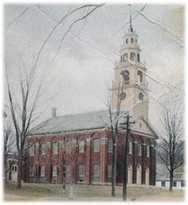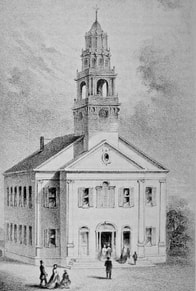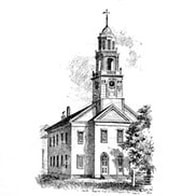Master Carpenter
John Leach charged $6 for his plans of the South Church. He was also paid for raising its timber frame and waived the design fee. After Newport, Leach's reputation grew and he ultimately built five churches for five different denominations.
John Leach (1778–1865)
|
John Leach was born in 1778 at Manchester (MA). His family moved along with several others to the southern part of Dunbarton (NH), around 1795. In 1805, he married Nancy Tenney, daughter of local builder William Tenney, who constructed many homes and also the town's meetinghouse. Leach may have worked for Tenney for some period, but one source states that William Tenney left his family over a dispute with his father-in-law, Judge Page, in 1796, several years before Leach’s marriage to Nancy. Dunbarton town records list John Leach as a house carpenter, and he may well have built the Capt. Joseph Leach House for his father in 1808; he was later hired as carpenter and joiner for construction of Concord's first Phenix Hotel in 1818, but presumably he remained busy in the interim.
There is no clear evidence linking John Leach with Newport or with members of its building committee, so exactly how he received the commission remains a mystery. After framing the South Church, Leach built two private homes, one for James Breck and another for Hubbard Newton, before leaving Newport. Within months of the Newport church's dedication in March 1823, John Leach designed and raised an Elias Carter-style wooden church for the Presbyterian congregation in New Boston (NH). He then received commissions for the First Baptist Church, Merrimack County Bank, and Isaac Hill's Block—all in Concord (NH). These were brick buildings that repeat certain design elements employed at the church at Newport. During that period he purchased land on Main Street and built Leach's Block, a wooden structure known for its style and bow windows. In 1827, he built the stone Episcopal church in Hopkinton—a Gothic Revival departure from his earlier work. In 1829, he designed and built the wooden Second Congregational (Unitarian) Church, patterned after an Asher Benjamin design; it burned while being outfitted for gas illumination in 1854. Around 1836, John Leach moved to Boston as a merchant, but he returned to Concord within five years. There he built a few private houses on South Main Street, including a duplex for the Farrington brothers which is now listed on the National Register. His final work may have been the house at 10 Fayette Street, begun in 1848, and to which John and Nancy Leach retired in 1852. Ten years later, they moved to Brooklyn, New York, where they lived with their surviving son, Dr. John T. G. Leach. John Leach, 85, died in Brooklyn (NY) at the close of the Civil War in the spring of 1865, and his body was reportedly returned to Concord for burial. Nancy Leach died the following year at the age of 82. |



